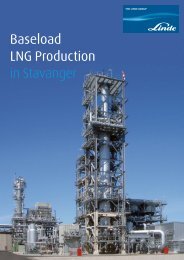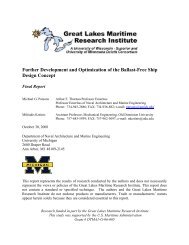15 MB - Great Lakes Maritime Research Institute
15 MB - Great Lakes Maritime Research Institute
15 MB - Great Lakes Maritime Research Institute
Create successful ePaper yourself
Turn your PDF publications into a flip-book with our unique Google optimized e-Paper software.
of a longterm lowtemperature storage test to verify that separation of the blendand preferential gelling of the biodiesel component does not occur is recommended.5. Our study also indicates that although shipboard use of fuel cells using biodiesel isenergy efficient and environment friendly, is very capital intensive and highlyunlikely to be economical.Biodiesel: An Alternative Fuel for <strong>Great</strong> <strong>Lakes</strong> Marine Vessels; Economic Analysis;Supply and Demand; Economic Impact ModelVolatile production and pricing associated with dynamic changes make modeling thebiodiesel industry challenging. For instance, for business planning, a breakeven analysisusually calculates a breakeven point based on fixed costs, variable costs per unit of sales,and revenue per unit of sales. Business planning at the level of individual enterprise issuggested as further research, and assumptions of perunit revenue and perunit cost aswell as assumption of other fixed costs would be estimated through a detailed salesforecast as well as profit and loss data from the industry. Given the aforementionedvolatility of this market, as seen in the supply and demand trends in the foregoing datatables, average sales and costs may not be representative. Analysts predict, however, thatcosts will come down and prices will rise, making the breakeven point a moving target.The variation in feedstock producers, type of feedstock, the possibility of increaseddemand from <strong>Great</strong> <strong>Lakes</strong> maritime fleets, “fixed” costs such as legislated incentives andregulations which can be amended or removed, and the technological advances inchemical processing and operations and enduse engineering can introduce new variablesat any stage of the business model.For the industry sector, it can be assumed that eventually the low cost producers will ableto force the independent producers out of the industry and capture market share. Changesin the industry sector will have impacts for the regional economy.An estimate of economic impacts to the <strong>Great</strong> <strong>Lakes</strong> region from the introduction of morebiodiesel production is provided. The use of biodiesel fuel by <strong>Great</strong> <strong>Lakes</strong> commercialfleets is expected to increase in the future. By the end of the decade, the demand forbiodiesel could be over 30 million gallons. Although over 23 million gallons of dieselsales were disclosed by two <strong>Great</strong> <strong>Lakes</strong> suppliers for this report, other <strong>Great</strong> <strong>Lakes</strong>producers would not reveal sales volume. Therefore total <strong>Great</strong> <strong>Lakes</strong> sales or productioncould not be reported. However, it is possible to assume that a new 30 million gallonsbiodiesel facility could be supported as the <strong>Great</strong> <strong>Lakes</strong> fleets convert to biodiesel usage.Data show that there was total domestic demand for 2.1 billion gallons of distillate fueloil for vessel bunkering in 2004. <strong>Great</strong> <strong>Lakes</strong> states maritime commerce consumes about170 million gallons of diesel fuel. Based on soybean production in 2005 it would onlytake about 9% of the states’ soybean production to satisfy demand for converted biodieselmaritime use. How quickly vessels will convert to biodiesel is unknowable, but some ofthis demand could be supplied by increased biodiesel production. To meet this increaseddemand a new <strong>Great</strong> <strong>Lakes</strong> Biodiesel Plant, of typical production capacity of 30 millionvi












